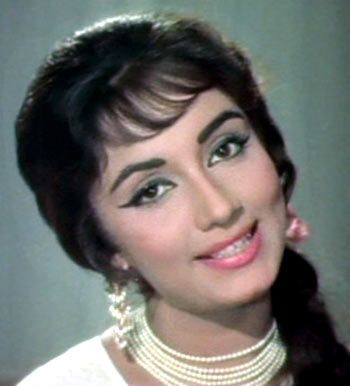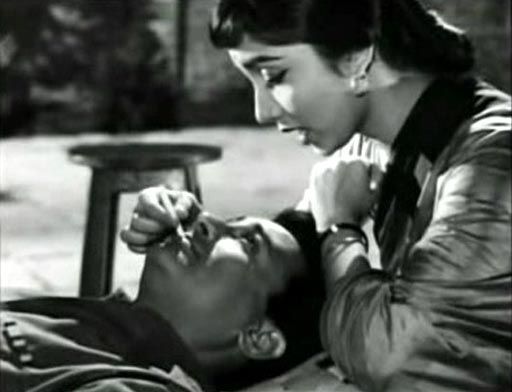 | « Back to article | Print this article |
'Her death has left a small hole in me. That little space that her songs and her screen image always filled in me. She had not worked in films for years, but somehow I always sensed she was there, somewhere in Bombay where movie magic is made,' says Aseem Chhabra.
 A few years ago, I went for a screening of Mere Mehboob, H S Rawail's 1963 classic with Rajendra Kumar and Sadhana. The afternoon screening -- part of the Muslim Socials in Bombay Cinema festival -- was held at New York City's Film Society of Lincoln Centre.
A few years ago, I went for a screening of Mere Mehboob, H S Rawail's 1963 classic with Rajendra Kumar and Sadhana. The afternoon screening -- part of the Muslim Socials in Bombay Cinema festival -- was held at New York City's Film Society of Lincoln Centre.
The film opens with Rajendra Kumar singing the title song in Mohammed Rafi's voice. But later when Lata Mangeshkar sang the same song, I realised a woman in my row -- and the theatre was nearly empty -- was humming Mere Mehboob Tujhe Meri Mohabbat Ki Kasam. And just like that I joined this desi woman, singing softly one of the most popular songs of my childhood and teenage years.
Sadhana was on the screen, standing in the middle of a room, surrounded by friends who quietly watched her small gestures. She wore a purple chooridar-kurta, her hair was styled in the Sadhana cut, and she basically played to the emotions that Lata's voice was expressing.
It was a lovely moment connecting with my Indian roots. In the dark of a theatre on Manhattan's Upper West Side, I was not shy to admit that I was an Indian and Sadhana's elegant presence was a reminder that I loved old Hindi cinema.
Sadhana passed away last week and her death has left a small hole in me. That little space that her songs and her screen image always filled in me. She had not worked in films for years, but somehow I always sensed she was there, somewhere in Bombay where movie magic is made.
I was very young when Sadhana started acting in films in the early 1960s. There was no television then and my family did not have a tradition of often going out to see films. I knew her film songs as they played on Vividh Bharati long before I saw her films.
Living in Delhi, it was impossible to miss the songs. Radios would always be playing at neighbours' homes or even at panwallahs' stalls in markets.
I discovered Sadhana and her films in the 1970s on our bulky television set when her films would occasionally play in black and white on Sundays. We were a deprived generation. In the entire week Doordarshan would broadcast only one film, but even with that I discovered many gems of Indian cinema, including films with Sadhana -- Love in Simla (1960) Parakh (1960), Asli Naqli (1962), Woh Kaun Thi (1964), Mera Saya (1966), Anita (1967) and the hugely popular Waqt (1965).
Sadhana and all the actors of that era lived in the black and white world and that is how I remember them. I recently watched Waqt on YouTube and the colours looked odd, as if they had been added as an afterthought.
Sadhana has been alive in my life for many years through YouTube. I often revisit the beautiful songs she inhabits, a world that the actors own, even when in the background it is the singers, the lyricists and the music composers who are enhancing the emotional and sensory experience.
When I hear Mila Hai Kisika Jhumka from Parakh, my heart, mind and entire being starts to prance. And I am taken to my teenage years watching Chitrahaar on Doordarshan. I can smell that time, of innocence and discovering the joys of simple uncomplicated stories in Hindi films.
And Sadhana is in the midst of it all in a plain colored sari (perhaps orange I would like to image), a white blouse, her hair tied in a bun and with a bindi. Along with Nutan, Nanda, Asha Parekh, Mala Sinha and Waheeda Rahman, Sadhana represented that era -- quiet, beautiful which defines the adage Old is Gold!
Often she would have a gajra, a bunch of jasmine flowers tied around her hair bun, as in the gorgeous song Tera Mera Pyar Amar from Asli Naqli. The song has a faux quality to it: A night scene, set in a studio, Sadhana up on a terrace, Dev Anand with his big hairdo walking on the street towards her house, a light breeze, the reflection of trees and the moon, coupled with the perfect sounds of Hindi cinema -- Lata Mangeshkar's voice and melodious music composed by Shankar Jaikishen.
It is a magical combination. Everything feels right in that song.

There is also another memorable moment that Sadhana shares with Dev Anand in the opening song of Hum Dono (1962) as they sing Abhi Na Jao Chhodkar. That song should be appreciated in its original black and white format and not in the recent colorised version of the film. The director Amarjeet shot the film in black and white and that is how he visualised his romantic pair.
Even when Sadhana brought the mysterious in her in films like Woh Kaun Thi and Anita, or when she transitioned to a simple but sexy look -- whether it was through her fringe hairdo, the Audrey Hepburn-inspired Sadhana cut, or the short kurtas that FabIndia now sells, she was still the innocent beauty.
In a rare film like Bimal Roy's underappreciated Prem Patra (1962), Sadhana makes a grave mistake. She reports the hapless Shashi Kapoor to the medical college principal, thereby affecting his scholarship. But then she spends the rest of film making up for her wrongdoing, by caring for Shashi Kapoor who has been blinded by an explosion in a medical lab.
There is a sweet song from Prem Patra -- Yeh Mere Andhere Ujale Na Hote, Shashi looking terribly handsome with dark glasses, to account for his eye accident and Sadhana once again in a sari. And as it often happened with films of that time period, the lyrical composition is the work of Salil Choudhury.
In one instance, she had to be really bad -- the pretend drunk scene in the Kaise Rahoon Chup song from Inteqam (1969). But we know that scene had a purpose. Sadhana was not exactly overstepping the boundaries of the good, decent woman that we had learned to admire in her films.
She was never the actress with deep acting abilities. She never played roles that were often given to Nutan, Meena Kumari and Waheeda Rahman. She never won any major awards. But she was a star and she was happy being the sweet, coy, young woman draped in her saris or later in the chooridar-kurtas.
That is how I will always remember Sadhana.